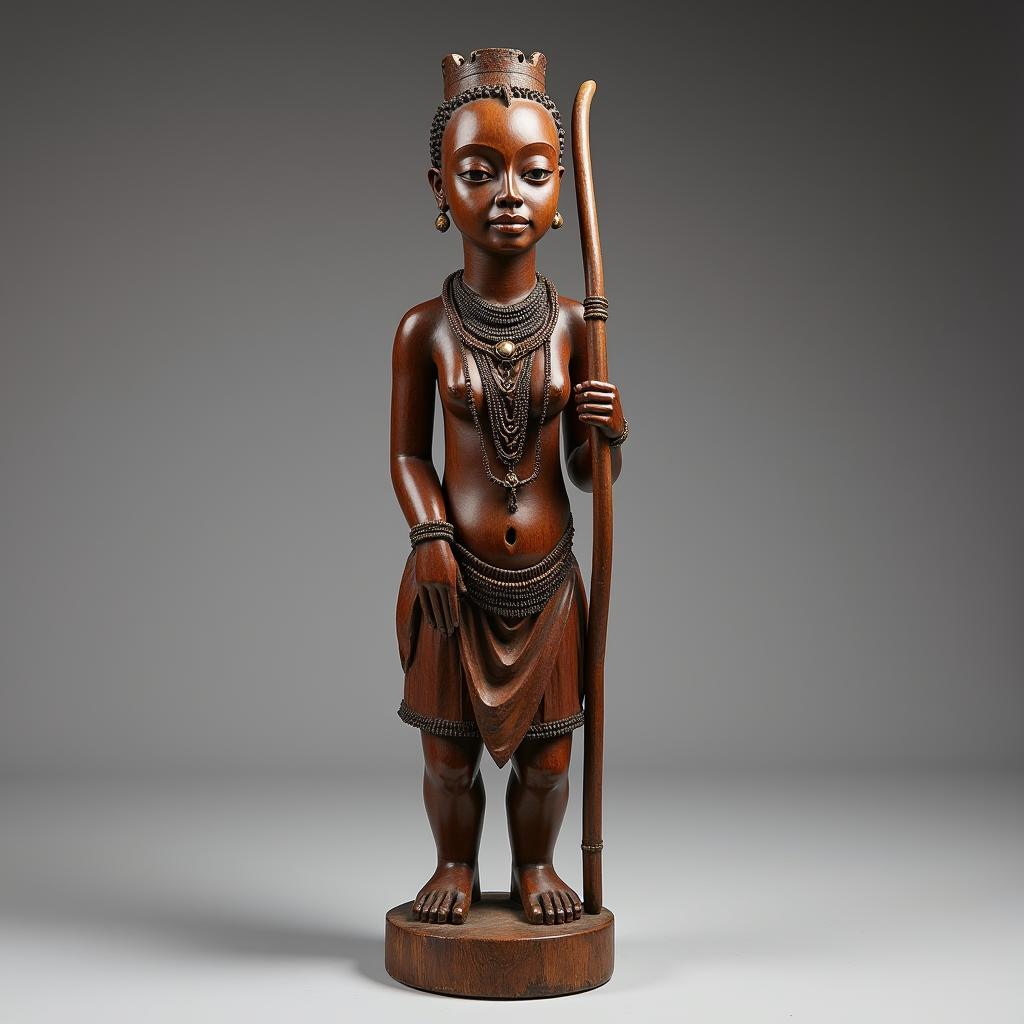Exploring the Majesty of African King Art
African King Art is more than just a visual spectacle; it’s a powerful window into the continent’s rich history, complex social structures, and vibrant cultural expressions. From ancient times to the present day, African artists have immortalized their rulers through diverse artistic mediums, each piece imbued with deep symbolism and meaning. These works of art are not mere portraits, but rather multifaceted narratives that communicate power, authority, lineage, and spiritual connection.
 Bronze sculpture of an African king
Bronze sculpture of an African king
Deciphering Symbolism: The Language of Royal Iconography
To truly appreciate African king art, one must delve into the language of its intricate symbolism. Crowns, often adorned with animal motifs or elaborate designs, represent power and authority. For example, the Benin kings of present-day Nigeria are renowned for their majestic beaded crowns, featuring coral beads and stylized representations of leopards, symbols of royal power and ferocity. Similarly, staffs, scepters, and fly-whisks held by the figures often signify leadership and the ability to command. These symbols are not merely decorative but serve as visual reminders of the king’s divine right to rule and their responsibility to their people.
 Wooden statue of an African queen mother
Wooden statue of an African queen mother
Beyond the Physical: Depicting Spiritual Authority
Beyond physical attributes, African king art often portrays the spiritual essence of leadership. In many African cultures, rulers were considered intermediaries between the physical and spiritual realms. Their ability to communicate with ancestors and deities was paramount to their legitimacy. This spiritual connection is frequently represented through the use of idealized features, exaggerated proportions, and the incorporation of symbolic objects associated with the divine.
For example, among the Yoruba people of Nigeria, kings are often depicted with elongated heads, representing wisdom and spiritual connection to higher realms. Similarly, the use of specific colors in sculptures and textiles, such as gold for royalty or blue for the divine, further reinforces the spiritual significance of these artworks.
Materials and Techniques: A Testament to Artistic Mastery
The diversity of African king art is also reflected in the wide range of materials and techniques employed. From majestic bronze sculptures cast using the lost-wax method to intricately carved wooden masks and figures, each region developed its own distinctive artistic traditions.
african designs coloring book marty noble offer a glimpse into the diverse patterns and designs used in African art. The use of natural pigments, derived from minerals, plants, and insects, resulted in a vibrant color palette that further enhanced the visual impact of these works.
From Palaces to Museums: The Legacy of African King Art
Historically, African king art served a variety of purposes beyond mere aesthetic appreciation. These works played an integral role in royal ceremonies, ancestral veneration, and the reinforcement of social hierarchies. Today, while some pieces remain in the custodianship of royal families or serve as sacred objects within communities, many examples of African king art are housed in museums and private collections around the world.
Where to Learn More about African King Art
- Visit Museums: Major art institutions like the British Museum, the Metropolitan Museum of Art, and the Musée du quai Branly – Jacques Chirac house significant collections of African art, including royal artifacts.
- Explore Online Resources: Websites like the Art Institute of Chicago and the National Museum of African Art offer virtual tours and detailed information on their collections.
- Read Scholarly Works: Numerous books and academic journals delve into the history, symbolism, and cultural context of African king art.
FAQs: Understanding African King Art
1. What is the significance of animal imagery in African king art?
Animals often represent specific qualities or powers attributed to the ruler. Lions might symbolize strength and courage, while leopards could denote cunning and swiftness.
2. How has colonialism impacted the perception and preservation of African king art?
Colonialism led to the looting and displacement of many African artifacts. However, it also sparked interest in African art in the West, leading to increased scholarship and appreciation.
3. Are there contemporary artists continuing the tradition of African king art?
Yes, many contemporary African artists draw inspiration from traditional royal art, reimagining its themes and aesthetics in their work.
For further information and assistance, please don’t hesitate to contact us:
Phone: +255768904061
Email: [email protected]
Address: Mbarali DC Mawindi, Kangaga, Tanzania
Our dedicated customer service team is available 24/7 to assist you.

